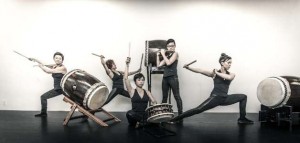Raging Asian Women: Challenging women stereotypes with Taiko Drumming
The first time I ever experienced a taiko performance I heard the deafening vibrations lapping against the walls, rippling in ever widening waves as they shook the ground beneath me. I was transfixed by the performance as the taiko players yelled while playing the odaiko, a drum about the size of a mini-fridge, and drummed up a storm within the packed auditorium. They were powerful, charismatic, and energized. And, most notably, they were all female. I could feel the rhythms pounding in my chest, thundering along my spine, reverberating within me as they finished their set. It was in that moment that I knew that I had to be part of it.
I was initially drawn to taiko because of its powerful expression and sound. As an ensemble-style art, taiko is known to engage and empower both its performers and audience. It’s loud. It’s assertive. Moreover, it demands attention and visibility where there is injustice and invisibility. Taiko in the United States as a cultural and historical medium of reinterpretation has its roots in the 1960’s as third-generation Japanese Americans rediscovered forms of cultural expression following the internment camps of World War II. This history of reinterpretation is also particularly important for Asian/Asian American women who are often stereotyped as quiet, mild-mannered, and submissive. Those who are seen as assertive or outspoken – particularly in the work place – risk being cast into “dragon lady” stereotype or receive surprising remarks about being uncharacteristically “loud.” The prevalence of these stereotypes and other oppressions have resulted in movements like the Twitter hashtag #NotYourAsianSidekick that launched as an Asian American feminist conversation starter and spurred other campaigns to address these issues. These issues have also attracted women to participate in movements and activities such as taiko which challenge stereotypes.
Taiko actively dispels many of the stereotypes, and it does so loudly and proudly. Drumming isn’t typically thought of as a “feminine” activity. However, taiko is unique in its progressive history in that the traditional idealization of taiko as a male dominated art form due to the physical demands of playing has shifted since the 1990’s in favor of equal gender roles as female membership soared. In fact, 75% of taiko players today are women and all-female taiko groups like Genki star, Raging Asian Women (RAW), and Taiko Sisters that act as networks of support, leadership, and empowerment against stereotypes are on the rise. This trend reflects a difficult, but successful renegotiation of gender roles over the years. As an ensemble style art form where close membership and collaboration are highly valued, taiko served as a space where early pioneering female taiko players who worked alongside their male counterparts helped to reverse initial stereotypes through their perseverance and artistry. Women taiko players have since moved from a history of being limited to dance routines during taiko performances to the center stage where they continue to renegotiate the future of the art form.
As a beginning taiko player in the 5C’s Psyko Taiko group, I’ve learned a lot about just how insanely demanding, fun, and invigorating playing taiko can be. The nerve-wracking hesitancy with which I initially played has given way to greater confidence as I have been encouraged to play loudly, to shout encouragements to my fellow group members, and to create my own solos. Like other women, I’ve come to see how taiko contradicts stereotypes by encouraging women to own their bodies and unapologetic expression through its physicality and powerful sound. Taiko takes control of authorship and works to subvert its own traditions, thereby serving as a more inclusive and empowering medium. And for me, taiko remains not only a fun way to relieve stress, but as a powerful way to readdress and redefine raging stereotypes of the quiet, demure Asian American women with the resounding sound of unapologetic challenge.
Staff Blogger Scr ’16

![[in]Visible Magazine](https://community.scrippscollege.edu/invisible/wp-content/uploads/sites/5/2011/04/Invisible-Masthead-2011-Spring1.png)









No comments yet... Be the first to leave a reply!